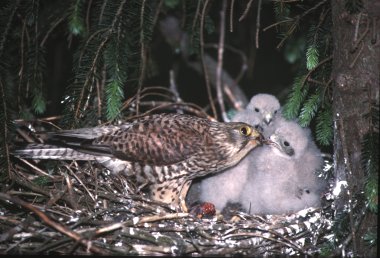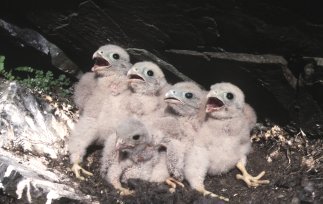Kestrels For
Company
available in bookstores
Satellite tagging of young kestrels
Annual kestrel summaries - Scotland

General Information
1. The kestrel is a middle sized falcon easily recognised by its hovering mode of hunting.
Up until the end of the 20th Century it was regarded as the commonest raptor in Britain but recently this status has been eclipsed by the dramatic expansion of the buzzard. The population of kestrels in Britain is currently estimated at around 35,400 breeding pairs, possibly 20% of the European population, the Scotland population standing at 7,000 7,500 pairs.

2. Having recovered well by the mid 1970s from the disastrous effects of organochlorine
pesticide poisoning of the late 1950s and 1960s, they have declined in the past 2 decades and are now no more common than in the early 1960s. In Scotland the 1968-72 breeding atlas recorded 889 10 km squares occupied by kestrels but by the time the second atlas was completed 1988-91 the number of squares occupied had fallen to 812. The breeding population was estimated at 11,000 pairs at that time but there has been an obvious decline since then. This decline has been attributed to changes in agricultural practice which has reduced and altered habitats which support the kestrelís main prey species. Increased predation by other raptors like the goshawk and peregrine falcon which have recovered from the lows of the 1960s and early 1970s, plus competition from the buzzard and barn owls may be having an effect on the kestrel population levels as well. It may be a natural readjustment of raptor species as populations of other raptors return to their previous levels. Conditions for the kestrel are no longer as favourable as in the 60s and 70s.
3. As with most small raptors the kestrel is very productive producing normally clutches of 4 to 6 eggs, having good brood survival and fledging success. Birds can breed in their first year if conditions are suitable. This high production rate compensates for the quick turnover of the population exemplified by the high mortality of first year birds and adults rarely exceeding 3 to 5 years of age.
4. In upland areas breeding numbers and productivity are very dependent upon an abundance of prey, especially the cyclic short tailed field vole, but the kestrel has a remarkable capacity for switching prey items and by doing so they manage to produce young even in years when the voles are in short supply. The nomadic nature of the bird means it can respond to the build up of prey numbers in an area.

5. The kestrel does not build a nest but scratches out a scrape in a ledge type situation either in a cliff face, a building, stick nest of another species, hole in a tree or even on the ground in Orkney where ground predators are absent.
6. Although the kestrel has very little conflict with manís activities it still features in persecution reports and with its decline has been given amber status in the UK (moderate decline 25-49% over the past 25 years) and in Europe terms is classed as having an unfavourable conservation status.
